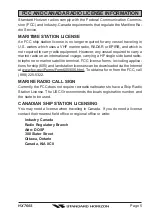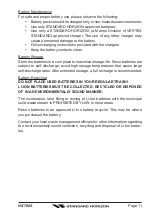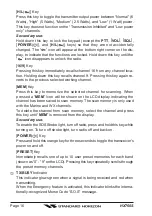
HX760S
Page 6
FCC / INDUSTRY CANADA INFORMATION
The following data pertaining to the transceiver is necessary to fill out the li-
cense application.
VHF Transceiver
FCC Type Accepted: ........................................................................... Part 80
Output Power with FNB-V99LI: ............1.0/2.5/5.0/6.0 W (Low/Mid/High/Nor)
Emission: ......................................................................................... 16K0G3E
Frequency Range: ................................................... 156.025 to 163.275 MHz
FCC Type Number: .................................................................. K6630323X30
Industry Canada Type Approval: ........................................... 511B-30323X30
Bluetooth
®
Unit
(
Built-in
)
FCC Type Accepted: .........................................................................Part 15C
Output Power: ............................................................................... 0.00056 W
Emission: ......................................................................................... 16K0G3E
Frequency Range: ............................................................. 2402 to 2480 MHz
FCC Type Number: .................................................................. K660F434X10
Industry Canada Type Approval: ........................................... 511B-0F434X10
FCC NOTICE
Unauthorized changes or modifications to this equipment may void compli-
ance with FCC Rules. Any change or modification must be approved in writing
by STANDARD HORIZON, a Marine Division of VERTEX STANDARD.
NOTICE
This equipment has been tested and found to comply with the limits for
a Class B digital device, pursuant to Part 15 of the FCC Rules. These
limits are designed to provide reasonable protection against harmful
interference in a residential installation. This equipment generates uses
and can radiate radio frequency energy and, if not installed and used in
accordance with the instructions, may cause harmful interference to ra-
dio communications. However, there is no guarantee that interference
will not occur in a particular installation. If this equipment does cause
harmful interference to radio or television reception, which can be de-
termined by turning the equipment off and on, the user is encouraged to
try to correct the interference by one or more of the following measures:
y
Increase the separation between the equipment and receiver.
y
Connect the equipment into an outlet on a circuit different from that
to which the receiver is connected.
y
Consult the dealer or an experienced marine electronics technician
for help.






































